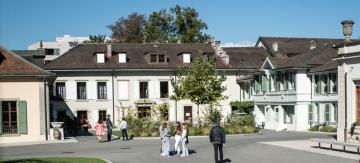Bienvenue sur le campus !
Notre campus se compose d’un charmant mélange de bâtiments modernes et anciens, dont un petit château du XVIIIe siècle, un Centre des arts ultra-moderne et un nouveau Centre sportif de pointe offrant des infrastructures exceptionnelles pour l'ensemble de nos élèves. Notre sentier didactique serpente à travers la forêt, mettant en valeur les principales essences d'arbres et d'autres points d'intérêt.
Nos Ecoles primaire, moyenne et secondaire bénéficient toutes d'un Centre STEM, de bibliothèques et de centres multi-media bien équipés, d’un excellent matériel informatique, de salles d’assemblées et de zones de détentes adaptées à chaque tranche d’âge.

Jonathan Halden
Directeur du campus et de l'Ecole secondaire, La Grande Boissière
Programme bilingue
Programmes enseignés en anglais et en français à tous les élèves du primaire jusqu'au secondaire
Programme du Diplôme du BI / PAU
Les élèves suivent notre propre programme, le Programme d'apprentissage universel, ainsi que le Programme du Diplôme du BI.
Soutien scolaire
Soutien scolaire pour les élèves présentant des difficultés d'apprentissage légères. Programme de soutien approfondi pour les élèves ayant des difficultés d'apprentissage modérées à importantes (places limitées)
Activités extrascolaires
Culture et loisirs, musique, sports, arts visuels, arts de la scène, danse, clubs... il y en a pour tous les goûts !

Les programmes de La Grande Boissière
Pionnière d’une éducation centrée sur l’enfant, l’Ecolint répond aux besoins de chaque élève en remplissant sa mission d'éduquer les élèves à être des citoyens du monde ayant la capacité et le courage de créer ensemble un lendemain juste et joyeux.
Nos services complémentaires
Cafétéria
Chaque jour, notre prestataire SV Group sert des repas sains et équilibrés et s'engage pour le respect de l'environnement et la promotion de pratiques d'élevage respectueuses des animaux.
Transports
Nous proposons un service de transport pour nos trois campus. Ce service couvre la région de Genève, du canton de Vaud et de la France voisine.
Accueil parascolaire
Ouvert tous les jours jusqu'à 18h00, l'accueil parascolaire de l'Ecolint est la solution idéale pour simplifier le quotidien de nos parents d'élèves.
Visitez notre campus !
Visites en personne
C'est avec plaisir que nous accueillons les visiteurs chaque semaine de la période scolaire aux horaires suivants :
- Ecole primaire (Pré-primaire 1 - Classe 4) : le mardi à 9h00
- Ecole moyenne (Classes 5 - 8) et Ecole secondaire (Classes 9 - 13) : le mardi à 10h00
Visites en ligne
Des rencontres en ligne avec la direction des écoles ont lieu pendant la période scolaire aux horaires suivants :
- Ecole primaire (Pré-primaire 1 - Classe 4) : mercredi à 13h00
- Ecole moyenne (Classes 5 - 8) : mercredi à 13h00
- Ecole secondaire (Classes 9 - 13) : mardi à 15h00
